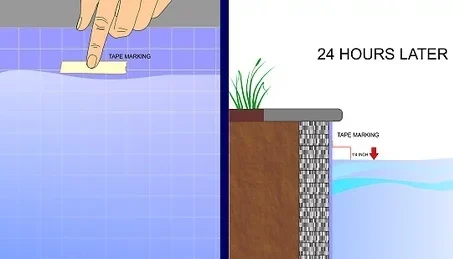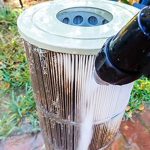Having a pool in your backyard is a wonderful luxury, but it also comes with its own set of responsibilities. One common issue that pool owners face is leaks. A leaking pool not only leads to water wastage but also can cause damage to the surrounding area. Therefore, it is essential to regularly check for pool leaks to prevent any major problems. In this article, we will discuss some effective ways to check for pool leaks.
1. Perform a Bucket Test
To find a leak in a pool, the bucket test is a simple yet effective way to determine if your pool is leaking. Here’s how you can perform the test:
- Fill a bucket with water to the same level as your pool.
- Place the bucket on the pool step or the top pool stairs.
- Mark the water level inside the bucket and the pool.
- After 24 hours, compare the water loss in the bucket to the pool. If the pool loses more water than the bucket, you may have a leak.
2. Check for Wet Spots
Walk around your pool area and look for any wet spots on the ground that are not caused by splashing water. These wet spots could indicate a leak in your pool’s plumbing or structure. Make sure to inspect the pool equipment area as well, as leaks can occur in the pipes or valves. Using the same technique you can also find out leaks in pool liners.

Credit: www.youtube.com
3. Examine the Pool Equipment
Inspect the pool equipment, including the pump, filter, and heater, for any signs of water leakage. Check for dampness, rust, or mineral deposits around the equipment, as these can be indicators of a leak. Also, look for any pool equipment that is constantly wet, as this could point to a leak.
4. Conduct a Dye Test
A dye test can help you pinpoint the exact location of a leak. Here’s how you can perform a dye test:
- Turn off the pool pump and let the water become calm.
- Add a few drops of food coloring near the suspected leak area.
- Observe the movement of the dye. If the dye is drawn into a crack or crevice, it indicates a leak.
5. Monitor the Pool’s Water Level
Keep an eye on your pool’s water level regularly. If you notice a significant drop in the water level that cannot be attributed to evaporation or splashing, it could be a sign of a leak. Monitoring the water level can help you detect leaks early on before they cause extensive damage.
6. Hire a Professional Leak Detection Service
If you suspect a leak but are unable to locate it, consider hiring a professional leak detection service. These experts use specialized equipment such as listening devices, pressure tests, and cameras to identify leaks in your pool. While it may involve a cost, hiring a professional can save you time and prevent further damage to your pool.
7. Repair the Leak
Once you have identified the source of the leak, it is crucial to repair it promptly to prevent any further water loss or damage. Depending on the type and location of the leak, you may need to patch a crack, replace a damaged pipe, or seal a leaking valve. If you are unsure how to repair the leak, it is best to consult a professional pool repair service.
8. Preventing Future Leaks
After repairing a leak, it is essential to take steps to prevent future leaks from occurring. Regularly inspect your pool for any signs of damage or wear and tear. Maintain proper water chemistry and balance to prevent corrosion of pool components. Additionally, avoid using sharp objects or abrasive cleaners that can damage the pool surface and lead to leaks.
Frequently Asked Questions
Q: What are common signs that my pool might have a leak?
A: Common signs include unexplained water loss, wet spots around the pool area, cracks or gaps in the pool structure, a sudden increase in water bills, and air or dirt blowing into the pool through the return lines.
Q: How much water loss is normal for a pool?
A: Normal evaporation can cause a pool to lose about 1/4 to 1/2 inch of water per day. Anything significantly more than this might indicate a leak.
Q: How can I differentiate between a leak and normal evaporation?
A: Perform a “bucket test”: Place a bucket filled with water on a pool step, mark the water levels inside the bucket and on the pool wall, and compare the levels after 24-48 hours. If the pool water level drops more than the bucket’s water level, you likely have a leak.
Q: Where are common locations for pool leaks?
A: Leaks often occur in the pool liner, around fittings and lights, at the skimmer, in the plumbing, and in the pool shell or structure.
Q: How do I check for leaks in the pool liner?
A: Conduct a dye test: Use a pool-safe dye or food coloring and squirt it near suspected areas. If the dye flows into a crack or hole, you’ve found the leak.
Q: What should I do if I suspect the plumbing is leaking?
A: Check for wet spots or sunken areas in the yard, which can indicate underground leaks. A pressure test can also be conducted by a professional to confirm plumbing leaks.
Q: How do I inspect the pool equipment for leaks?
A: Check all pool equipment such as the pump, filter, heater, and valves for visible signs of leaks. Look for water pooling around the equipment area.
Q: Can leaks occur in the pool structure itself?
A: Yes, structural leaks can happen due to cracks or damage in the pool shell, which can be caused by ground movement, settling, or poor construction.
Q: How can I fix a minor leak in the pool liner?
A: Minor leaks can often be patched using a pool patch kit, which includes adhesive and a patch material that can be applied underwater.
Q: Should I hire a professional to find and fix a pool leak?
A: While minor leaks can sometimes be fixed by the pool owner, major leaks or those that are difficult to locate should be handled by a professional to ensure proper repair.
Q: How can I prevent future leaks in my pool?
A: Regular maintenance, including checking and tightening fittings, inspecting the pool liner or shell for damage, and maintaining proper water chemistry, can help prevent leaks.
Q: What is the impact of a pool leak on pool equipment?
A: A pool leak can cause the pump to lose prime, reduce filtration efficiency, and potentially damage the pump and other equipment due to running dry or working harder to compensate for lost water.
Q: Can a leak affect the structural integrity of my pool?
A: Yes, continuous water loss can undermine the pool structure, leading to more severe damage and costly repairs if not addressed promptly.
Q: Is it possible for the leak to be in the skimmer?
A: Yes, leaks can occur in the skimmer due to cracks or poor seals. Inspect the skimmer and use dye to check for any leaks around the area.
Q: How often should I check my pool for leaks?
A: Regularly inspect your pool at the beginning and end of the swimming season, and whenever you notice unusual water loss or other symptoms of a leak.
Final Words
Checking for pool leaks is an essential part of pool maintenance. By following the tips mentioned in this article, you can effectively identify and repair leaks in your pool, ensuring its longevity and preventing water wastage. Remember to regularly inspect your pool, perform tests, and take preventive measures to keep your pool in top condition. If you are unable to locate a leak or are unsure how to repair it, do not hesitate to seek professional help. A leak-free pool will not only save you money but also provide a safe and enjoyable swimming experience for you and your family.





